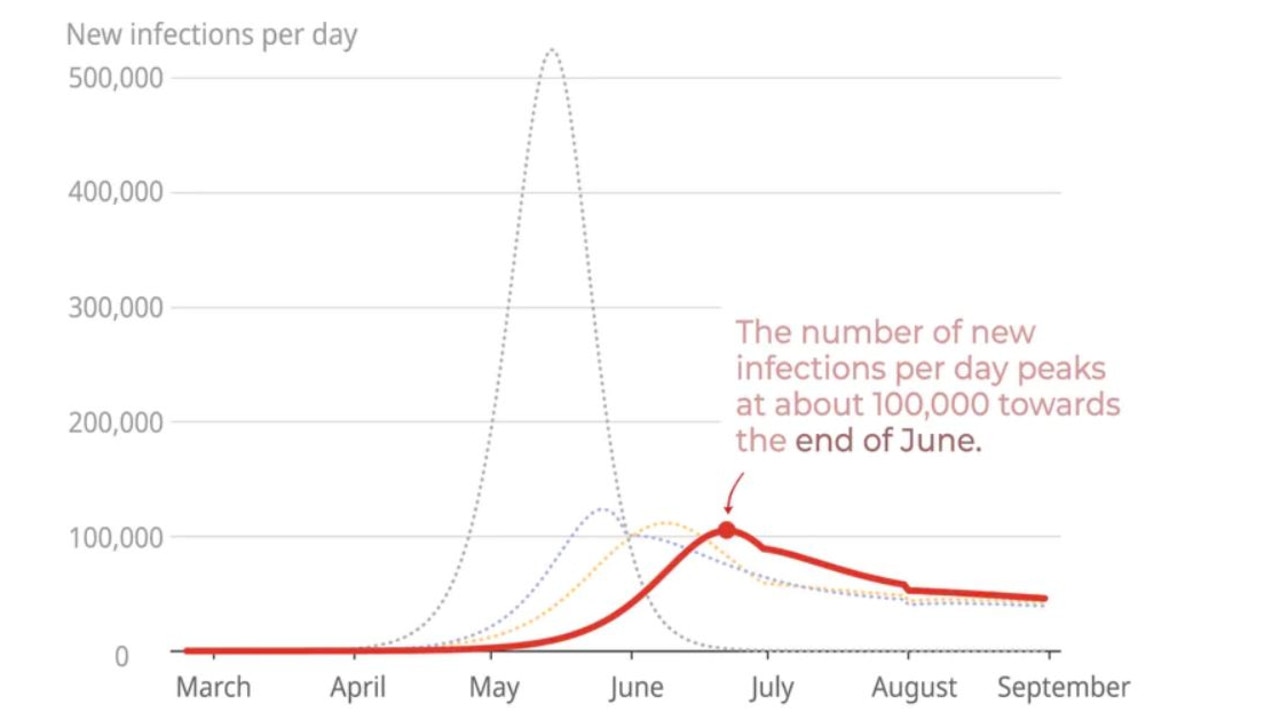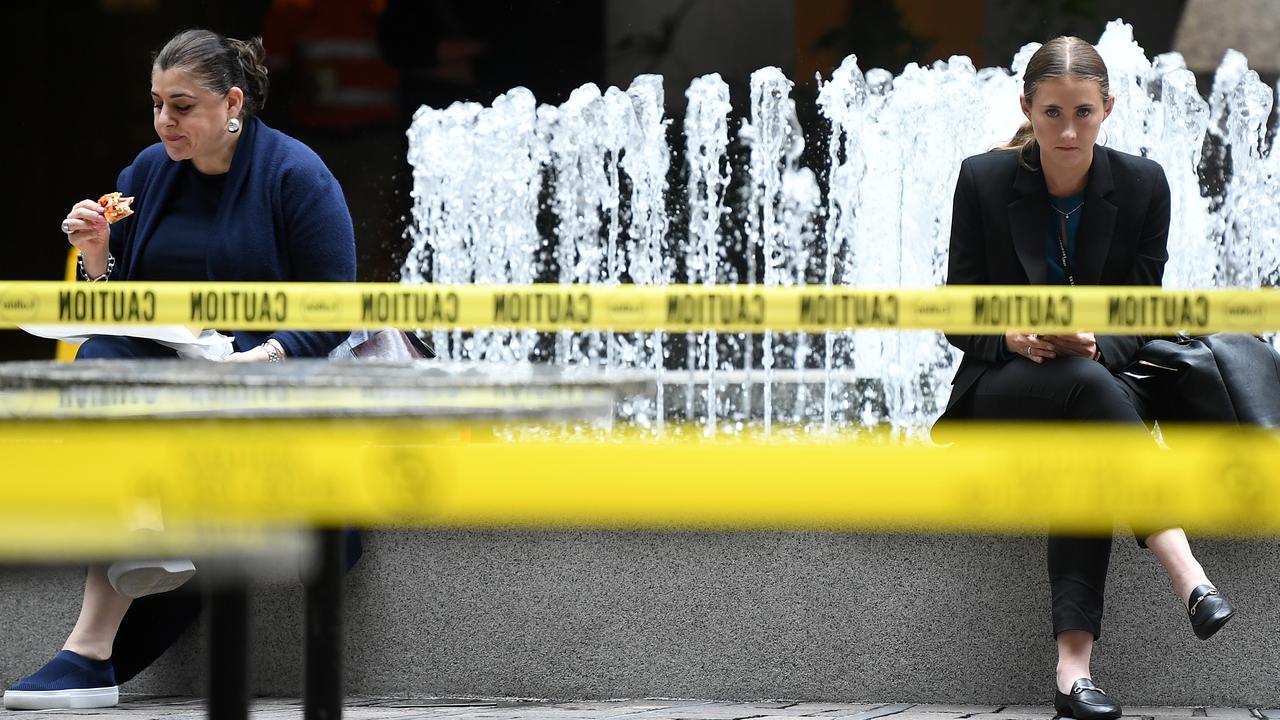‘Flattening the curve’ would see an estimated 15 million Australians get coronavirus and about 134,000 deaths
“Flattening the curve” would see 15 million Aussies infected with coronavirus and about 134,000 deaths, according to expert analysis. But there is another option.

About 15 million Australians would become infected with coronavirus if the country takes the path of “flattening the curve”.
Australia currently has a number of options to deal with the coronavirus pandemic and a lot of the focus has been on this particular strategy.
But while many people may understand that it is aimed at slowing down the rate of infections, they may not realise that its end point is for 60 per cent of the population to eventually be infected.
Essentially about 15 million Australians need to be infected with coronavirus to achieve “herd immunity”, University of Melbourne Professor of Epidemiology Tony Blakely told news.com.au. Once this happens, the virus won’t be spread as easily because most people will have developed an immunity to it.
Flattening the curve, through introducing measures to slow the spread of the virus, can save lives because it will be easier for people who do get seriously ill to access treatment if the influx of patients is smaller.
However, peak infections in Australia would still be likely to reach between 100,000 and 500,000 cases a day, depending on the measures taken to slow the spread, according to models produced by Prof Blakely.
Prof Blakely said peak infections per day would only reach 500,000 if the epidemic was left to run its natural course.
But social distancing measures Australia has already taken will lessen that peak.
Prof Blakely’s modelling suggests infections may peak at around 100,000 cases a day towards the end of June, with measures to ‘flatten the curve’.
He said not everyone who was infected would have symptoms, so 100,000 infections translates to about 30,000 symptomatic cases.
This would translate to about 3000 people a day that may need hospitalisation, with about 1200 or so people who may need intensive care.
“If we protect our elderly really well, then the numbers may be half of hospitalisations and ICU cases might be half these again,” Prof Blakely said.
RELATED: Follow coronavirus updates, latest news and death toll
RELATED: Coronavirus could send house prices plummeting by 20 per cent

Prof Blakely’s predictions were based on infections doubling every four days, rather than every three days, which is what Australia appears to be experiencing now. If infections are doubling every three days then the peaks would be reached slightly sooner.
Grattan Institute chief executive officer John Daley has been critical of the strategy to flatten the curve and points out that Australia is likely to run out of intensive care capacity when there are about 45,000 infections.
This would ramp up pressure on authorities to close down the country but by then it will be too late to change tack.
Mr Daley said it could also fling Australia into a cycle dubbed the “epidemic yoyo”, with the public likely pressuring the government to re-open businesses too early, leading to more infections until a death rate again becomes unacceptable, leading to more shutdowns.
“Flattening the curve will require us to suppress economic and social activity for at least 12 months, and possibly much longer,” Mr Daley suggested in an analysis piece.
Prof Blakely has estimated 134,000 Australians would die if the country adopted flattening the curve as its strategy.
He is hopeful this can be brought down to about 30,000 deaths if treatments improve and the elderly are protected as a priority and their infection rate is reduced from 60 per cent to 20 per cent.
“That’s not bad when you consider about 19,000 a year die from tobacco-related causes in Australia,” Prof Blakely said.
RELATED: Leaders to consider ‘stage 2’ lockdown in Australia
RELATED: Unexpected sign you might have coronavirus

THE ‘ERADICATION’ ALTERNATIVE
Prof Blakely told news.com.au that flattening the curve was a very different tactic to “eradication”, which is what places like Wuhan in China have achieved.
“Eradication” would involve a total lockdown of Australians, including schools and businesses, in the hopes of squashing the virus within two to six weeks.
It would likely require rigorous contact tracing and for everyone to quarantine themselves.
This may see deaths from coronavirus fall to about 5000.
Once the virus was gone, life in Australia could return to normal, although it would have to operate separately to the rest of the world for 12 to 16 months while a vaccine was developed.
“It’s not easy but it is achievable,” Prof Blakely said. “But if that’s the option then we haven’t acted quickly enough.”
Prof Blakely says Australia was running out of time to implement this option.
The advantage of this strategy is that Australia may only have to shutdown for eight to 12 weeks, according to the Grattan Institute.
Mr Daley argues that “eradication”, what he refers to as “Endgame C” or “stop then restart”, would at least allow domestic travel, hospitality and other local activities in Australia to begin again once the shutdown is over.
Anyone who wanted to enter Australia, even Australian citizens, would likely have to enter forced quarantine for 14 days.
“Once infections are at zero, and stay there for a fortnight or so to ensure there are no asymptomatic cases, economic and social activity can restart sequentially, although international borders would have to remain closed to passenger traffic until there is a vaccine,” Mr Daley wrote.
“If our major trading partner – China – also successfully executes the same strategy, our major exports might continue as well.
“More importantly, if it is communicated clearly, Endgame C would give businesses a plausible end date.”
Yesterday Prof Blakely said the federal and state governments had just 48 hours to decide on what path they wanted to take, and whether the approach should be to “flatten the curve” or to try and eradicate the virus in Australia.
“The thing at the moment, is we need our Prime Minister and our state premiers to actually agree on what that strategy is and to communicate it to the public,” he said.
“We have 48 hours to reach a consensus and to tell the public what that goal is. Then we need to look at the policies that have been put in place and whether they will achieve those goals.”
Continue the conversation @charischang2 | charis.chang@news.com.au




